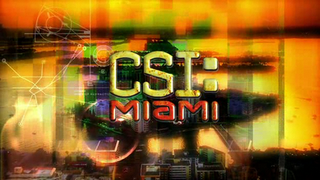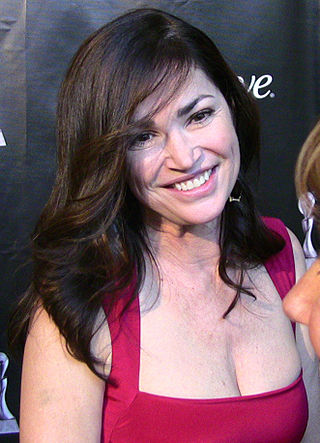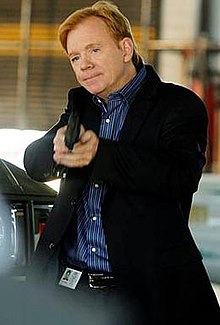
David Stephen Caruso is an American retired actor and producer, best known for his roles as Detective John Kelly on the ABC crime drama NYPD Blue (1993–1994) and Lieutenant Horatio Caine on the CBS series CSI: Miami (2002–2012). He appears in the feature films An Officer and a Gentleman, First Blood, Twins (1988), King of New York (1990), Kiss of Death (1995) and Proof of Life (2000).

CSI: Miami is an American police procedural drama television series that ran from September 23, 2002 until April 8, 2012 on CBS. Featuring David Caruso as Lieutenant Horatio Caine, Emily Procter as Detective Calleigh Duquesne, and Adam Rodriguez as Detective Eric Delko, the series is the first direct spin-off of CSI: Crime Scene Investigation, "transplanting the same template and trickery—gory crimes, procedural plot and dazzling graphics—into [a new city] while retaining the essence of the original idea".

CSI: NY is an American police procedural television series that ran on CBS from September 22, 2004, to February 22, 2013, for a total of nine seasons and 197 original episodes. The show follows the investigations of a team of NYPD forensic scientists and police officers identified as "Crime Scene Investigators" as they unveil the circumstances behind mysterious and unusual deaths, as well as other crimes. The series is an indirect spin-off from the veteran series CSI: Crime Scene Investigation and a direct spin-off from CSI: Miami, during an episode in which several of the CSI: NY characters made their first appearances. It is the third series in the CSI franchise.

Kim Delaney is an American actress known for her starring role as Detective Diane Russell on the ABC drama television series NYPD Blue, for which she won an Emmy Award. Early in her career, she played the role of Jenny Gardner in the ABC daytime television drama All My Children. She later had leading roles in the short lived TV drama Philly, part of the first season of CSI: Miami, and the first six seasons of Army Wives. She also appeared in Tour of Duty, Season 2 and the first two episodes of Season 3, as reporter Alex Devlin.
"Cross Jurisdictions" is the twenty-second episode of the second season of the American crime drama television series CSI: Crime Scene Investigation, which is set in Las Vegas, Nevada, and the 45th episode overall. Written by Ann Donahue, Carol Mendelsohn and series creator Anthony E. Zuiker and directed by Danny Cannon, the episode also served as a backdoor pilot episode of the spin-off series, CSI: Miami, set in Miami. The episode aired on CBS on May 9, 2002.
"Golden Parachute" is the first episode of the first season of the American crime drama CSI: Miami. The episode first aired on September 23, 2002 on CBS. This was the first of only 10 episodes featuring Kim Delaney as Megan Donner.

The second season of CSI: Crime Scene Investigation premiered on CBS on September 27, 2001, and ended May 16, 2002. The series stars William Petersen and Marg Helgenberger.

CSI is a media franchise of American television series created by Anthony E. Zuiker. The first three CSI series follow the work of forensic scientists as they unveil the circumstances behind mysterious deaths, while the fourth series, CSI: Cyber, emphasizes behavioral psychology and how it can be applied to cyber forensics.
"MIA/NYC NonStop" is the twenty-third episode in the second season of the American crime drama CSI: Miami and also served as backdoor pilot for the spin-off CSI: NY. The episode aired on May 17, 2004 on CBS.

The fifth season of CSI: Miami premiered on CBS on September 18, 2006 and ended May 14, 2007. The series stars David Caruso and Emily Procter.

The first season of CSI: Miami premiered on CBS on September 23, 2002, and ended on May 19, 2003. The show's regular time slot was Mondays at 10:00 pm. The series stars David Caruso, Emily Procter, and Kim Delaney.

The second season of CSI: Miami premiered on CBS on September 22, 2003, and ended May 24, 2004. The series stars David Caruso and Emily Procter.

The third season of CSI: Miami premiered on CBS on September 20, 2004. The season finale aired on May 23, 2005. The series stars David Caruso and Emily Procter.

The fourth season of CSI: Miami premiered on CBS on September 19, 2005 and ended May 22, 2006. The series stars David Caruso and Emily Procter.

The sixth season of CSI: Miami premiered on CBS on September 24, 2007 and ended May 19, 2008. The series stars David Caruso and Emily Procter.

The seventh season of CSI: Miami premiered on CBS on September 22, 2008 and ended May 18, 2009. The series stars David Caruso and Emily Procter.

The tenth and final season of CSI: Miami premiered on CBS on September 25, 2011, and is the shortest season of CSI: Miami with only 19 episodes. The series stars David Caruso, Emily Procter and Adam Rodriguez.














